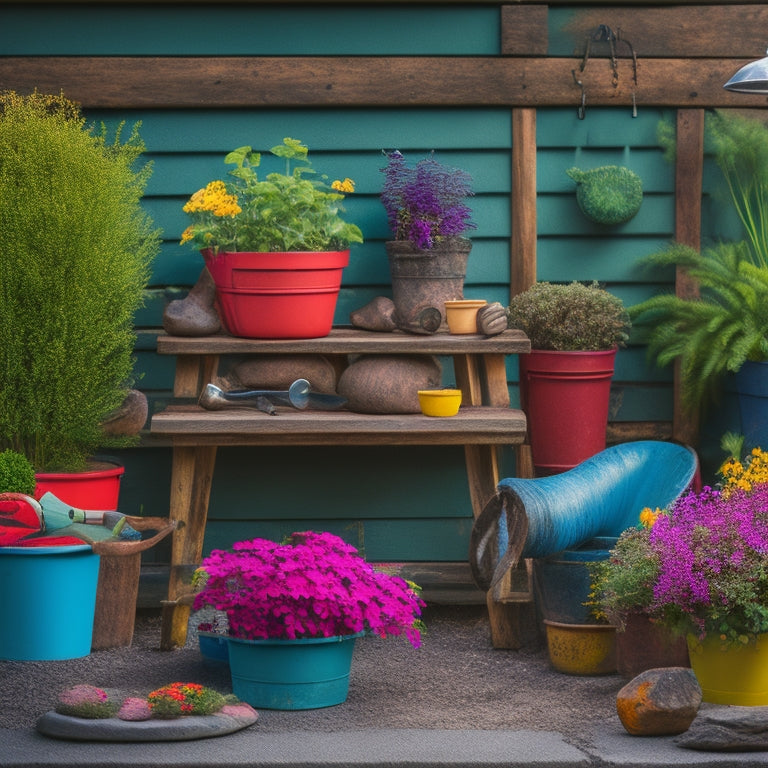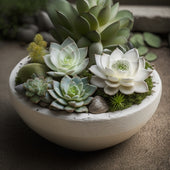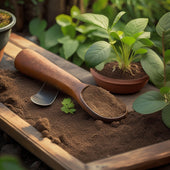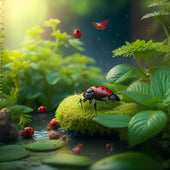
3 Best Tools for Planting and Maintaining Planters
Share
When it comes to planting and maintaining planters, you'll need a combination of three essential tools to get the job done. First, invest in a high-quality digging tool like a trowel or small shovel to create holes for your plants. Next, use a soil preparation tool like a rake or cultivator to loosen and prepare the soil. Finally, employ a targeted watering system like a watering can or hose with a fine nozzle to deliver water exactly where it's needed. With these three tools in your arsenal, you'll be well on your way to creating thriving planters - and there's more to learn to guarantee their continued success.
Key Takeaways
• A high-quality trowel or small shovel is essential for digging holes and planting in planters.
• A rake or cultivator is necessary for loosening and preparing soil for planting.
• A watering can or hose with a fine nozzle is ideal for targeted watering and maintaining soil moisture.
• A garden fork is useful for breaking up clods and aerating soil to promote healthy plant growth.
• A soil test kit can help verify pH and nutrient levels, ensuring optimal plant health and development.
Essential Tools for Block Planting
When preparing for block planting, you'll need a set of essential tools to guarantee a successful and efficient process. Block planting techniques require precision and control, and the right equipment can make all the difference.
You'll need a high-quality trowel or small shovel to dig holes for each block, as well as a rake or cultivator to loosen and prepare the soil. A garden fork can also come in handy for breaking up clods and aerating the soil.
In addition to these essential planting equipment, you may also want to reflect on a soil test kit to verify your soil has the right pH and nutrient levels for your plants. A watering can or hose with a fine nozzle can help you deliver water directly to the roots of each plant, reducing evaporation and runoff.
Choosing the Right Tool Kit
You'll need to assess your specific gardening needs and preferences to select a tool kit that's tailored to your planter maintenance routine. This process involves evaluating the types of plants you're growing, the size and material of your planters, and the frequency of maintenance. By considering these factors, you can create a list of vital tools that will make your maintenance tasks more efficient.
When it comes to tool selection, it's important to prioritize quality over quantity. Instead of buying a large, generic toolkit, focus on acquiring high-quality, specialized tools that cater to your specific needs. For instance, if you have a lot of small planters, a compact trowel and pruner set might be more suitable than a bulky, all-purpose toolkit.
In terms of toolkit essentials, consider including a good quality trowel, pruners, cultivator, and watering can. These tools will allow you to perform a range of tasks, from planting and pruning to watering and fertilizing. By investing in a well-curated toolkit, you'll be better equipped to maintain your planters and guarantee they thrive.
Effective Planter Maintenance Tips
Effective Planter Maintenance Tips
Regularly inspect your planters to catch potential issues early, and make adjustments to soil, water, and nutrient levels to keep your plants thriving. By doing so, you'll be able to identify and address any problems before they become severe.
| Task | Frequency | Importance |
|---|---|---|
| Watering | Daily (during hot weather) | High |
| Soil Testing | Quarterly | Medium |
| Pruning | Bi-weekly | High |
To maintain peak plant health, create a watering schedule tailored to your plants' specific needs. Don't forget to adjust your schedule according to weather conditions. Additionally, perform regular soil testing to guarantee the pH levels and nutrient content are suitable for your plants. By doing so, you'll be able to make informed decisions about fertilizer application and pH adjustments. By following these tips, you'll be well on your way to becoming a master planter. Remember, a well-maintained planter is a happy planter!
Frequently Asked Questions
How Often Should I Clean My Gardening Tools to Prevent Rust?
You should clean your gardening tools after every use to prevent rust.
Regular tool maintenance is essential to extend their lifespan.
Wipe them down with a dry cloth, removing any dirt or debris.
For tougher grime, mix baking soda and water to create a paste, then scrub and rinse.
Dry thoroughly to prevent moisture buildup.
Can I Use the Same Soil for Multiple Planters and Seasons?
When it rains, it pours - and so does the soil's potential for contamination!
Can you use the same soil for multiple planters and seasons? Technically, yes, but you'll need to take precautions.
Implement soil sterilization methods, like solarization or pasteurization, to kill off pathogens.
Additionally, incorporate seasonal soil amendments to replenish nutrients and adjust pH levels.
What Is the Ideal Storage Temperature for Planters During Winter?
When storing planters during winter, you'll want to keep them in an area with an ideal temperature between 35°F and 45°F (2°C and 7°C). This range prevents water from freezing and expanding, which can crack or break planters made of certain materials.
Look for planters made from durable, frost-resistant materials like ceramic or stone.
Additionally, consider using winter planter insulation to protect your planters from extreme temperatures and guarantee they remain in good condition until the next planting season.
How Do I Prevent Pests From Transferring Between Planters?
As you delicately tend to your planters, remember the ancient wisdom of 'divide and conquer' - but this time, it's about keeping pests at bay.
You'll want to prevent those unwanted critters from transferring between planters, spreading disease and destruction. Implement pest control measures like sterilizing your tools and washing your hands between plants.
Consider companion planting, where certain species naturally repel pests, keeping your planters healthy and thriving.
Can I Reuse Potting Mix From Last Season's Planters?
You're wondering if you can reuse potting mix from last season's planters. While it's tempting to reuse, it's generally not recommended.
Old potting mix can harbor diseases and pests, negating any potting mix benefits.
Instead, consider soil amendment techniques like adding organic matter or perlite to improve structure and fertility.
Start fresh with new potting mix to guarantee a healthy growing environment for your plants.
Conclusion
With the right tools in your arsenal, you'll be a planter master, effortlessly taming even the most unruly planters!
Having the essential tools for block planting and following effective maintenance tips will have your planters looking their absolute best.
And with these three must-haves, you'll be a pro in no time - a million times over!
Related Posts
-

What Makes a Great Planter for Succulents
When selecting a great planter for succulents, you'll want to take into account a combination of factors to guarantee...
-

What Makes a Great Planter for Succulents
When selecting a great planter for succulents, you'll want to take into account a combination of factors to guarantee...
-

What Makes a Great Planter for Succulents
When selecting a great planter for succulents, you'll want to take into account a combination of factors to guarantee...
-

What Makes a Great Planter for Succulents
When selecting a great planter for succulents, you'll want to take into account a combination of factors to guarantee...
-

What Makes a Great Planter for Succulents
When selecting a great planter for succulents, you'll want to take into account a combination of factors to guarantee...
-

What Makes a Great Planter for Succulents
When selecting a great planter for succulents, you'll want to take into account a combination of factors to guarantee...
-

What Makes a Great Planter for Succulents
When selecting a great planter for succulents, you'll want to take into account a combination of factors to guarantee...
-

What Makes a Great Planter for Succulents
When selecting a great planter for succulents, you'll want to take into account a combination of factors to guarantee...
-

What Makes a Great Planter for Succulents
When selecting a great planter for succulents, you'll want to take into account a combination of factors to guarantee...
-

What Makes a Great Planter for Succulents
When selecting a great planter for succulents, you'll want to take into account a combination of factors to guarantee...
-

What Makes a Great Planter for Succulents
When selecting a great planter for succulents, you'll want to take into account a combination of factors to guarantee...
-

What Makes a Great Planter for Succulents
When selecting a great planter for succulents, you'll want to take into account a combination of factors to guarantee...
-

What Makes a Great Planter for Succulents
When selecting a great planter for succulents, you'll want to take into account a combination of factors to guarantee...
-

What Makes a Great Planter for Succulents
When selecting a great planter for succulents, you'll want to take into account a combination of factors to guarantee...
-

What Makes a Great Planter for Succulents
When selecting a great planter for succulents, you'll want to take into account a combination of factors to guarantee...
-

What Makes a Great Planter for Succulents
When selecting a great planter for succulents, you'll want to take into account a combination of factors to guarantee...
-

What Makes a Great Planter for Succulents
When selecting a great planter for succulents, you'll want to take into account a combination of factors to guarantee...
-

What Makes a Great Planter for Succulents
When selecting a great planter for succulents, you'll want to take into account a combination of factors to guarantee...
-

What Makes a Great Planter for Succulents
When selecting a great planter for succulents, you'll want to take into account a combination of factors to guarantee...
-

What Makes a Great Planter for Succulents
When selecting a great planter for succulents, you'll want to take into account a combination of factors to guarantee...
-

What Makes a Great Planter for Succulents
When selecting a great planter for succulents, you'll want to take into account a combination of factors to guarantee...
-

What Makes a Great Planter for Succulents
When selecting a great planter for succulents, you'll want to take into account a combination of factors to guarantee...
-

What Makes a Great Planter for Succulents
When selecting a great planter for succulents, you'll want to take into account a combination of factors to guarantee...
-

What Makes a Great Planter for Succulents
When selecting a great planter for succulents, you'll want to take into account a combination of factors to guarantee...
-

What Makes a Good Used Trowel for Planters
When searching for a good used trowel for planters, you'll want to prioritize corrosion-resistant materials like stai...
-

What Makes a Good Used Trowel for Planters
When searching for a good used trowel for planters, you'll want to prioritize corrosion-resistant materials like stai...
-

What Makes a Good Used Trowel for Planters
When searching for a good used trowel for planters, you'll want to prioritize corrosion-resistant materials like stai...
-

What Makes a Good Used Trowel for Planters
When searching for a good used trowel for planters, you'll want to prioritize corrosion-resistant materials like stai...
-

What Makes a Good Used Trowel for Planters
When searching for a good used trowel for planters, you'll want to prioritize corrosion-resistant materials like stai...
-

What Makes a Good Used Trowel for Planters
When searching for a good used trowel for planters, you'll want to prioritize corrosion-resistant materials like stai...
-

What Makes a Good Used Trowel for Planters
When searching for a good used trowel for planters, you'll want to prioritize corrosion-resistant materials like stai...
-

What Makes a Good Used Trowel for Planters
When searching for a good used trowel for planters, you'll want to prioritize corrosion-resistant materials like stai...
-

What Makes a Good Used Trowel for Planters
When searching for a good used trowel for planters, you'll want to prioritize corrosion-resistant materials like stai...
-

What Makes a Good Used Trowel for Planters
When searching for a good used trowel for planters, you'll want to prioritize corrosion-resistant materials like stai...
-

What Makes a Good Used Trowel for Planters
When searching for a good used trowel for planters, you'll want to prioritize corrosion-resistant materials like stai...
-

What Makes a Good Used Trowel for Planters
When searching for a good used trowel for planters, you'll want to prioritize corrosion-resistant materials like stai...
-

What Makes a Good Used Trowel for Planters
When searching for a good used trowel for planters, you'll want to prioritize corrosion-resistant materials like stai...
-

What Makes a Good Used Trowel for Planters
When searching for a good used trowel for planters, you'll want to prioritize corrosion-resistant materials like stai...
-

What Makes a Good Used Trowel for Planters
When searching for a good used trowel for planters, you'll want to prioritize corrosion-resistant materials like stai...
-

What Makes a Good Used Trowel for Planters
When searching for a good used trowel for planters, you'll want to prioritize corrosion-resistant materials like stai...
-

What Makes a Good Used Trowel for Planters
When searching for a good used trowel for planters, you'll want to prioritize corrosion-resistant materials like stai...
-

What Makes a Good Used Trowel for Planters
When searching for a good used trowel for planters, you'll want to prioritize corrosion-resistant materials like stai...
-

What Makes a Good Used Trowel for Planters
When searching for a good used trowel for planters, you'll want to prioritize corrosion-resistant materials like stai...
-

What Makes a Good Used Trowel for Planters
When searching for a good used trowel for planters, you'll want to prioritize corrosion-resistant materials like stai...
-

What Makes a Good Used Trowel for Planters
When searching for a good used trowel for planters, you'll want to prioritize corrosion-resistant materials like stai...
-

What Makes a Good Used Trowel for Planters
When searching for a good used trowel for planters, you'll want to prioritize corrosion-resistant materials like stai...
-

What Makes a Good Used Trowel for Planters
When searching for a good used trowel for planters, you'll want to prioritize corrosion-resistant materials like stai...
-

What Makes a Good Used Trowel for Planters
When searching for a good used trowel for planters, you'll want to prioritize corrosion-resistant materials like stai...
-

10 Essential Tips to Prevent Disease in Vertical Gardens
You're about to discover the essential strategies to protect your vertical garden from disease, ensuring a thriving a...
-

10 Essential Tips to Prevent Disease in Vertical Gardens
You're about to discover the essential strategies to protect your vertical garden from disease, ensuring a thriving a...
-

10 Essential Tips to Prevent Disease in Vertical Gardens
You're about to discover the essential strategies to protect your vertical garden from disease, ensuring a thriving a...
-

10 Essential Tips to Prevent Disease in Vertical Gardens
You're about to discover the essential strategies to protect your vertical garden from disease, ensuring a thriving a...
-

10 Essential Tips to Prevent Disease in Vertical Gardens
You're about to discover the essential strategies to protect your vertical garden from disease, ensuring a thriving a...
-

10 Essential Tips to Prevent Disease in Vertical Gardens
You're about to discover the essential strategies to protect your vertical garden from disease, ensuring a thriving a...
-

10 Essential Tips to Prevent Disease in Vertical Gardens
You're about to discover the essential strategies to protect your vertical garden from disease, ensuring a thriving a...
-

10 Essential Tips to Prevent Disease in Vertical Gardens
You're about to discover the essential strategies to protect your vertical garden from disease, ensuring a thriving a...
-

10 Essential Tips to Prevent Disease in Vertical Gardens
You're about to discover the essential strategies to protect your vertical garden from disease, ensuring a thriving a...
-

10 Essential Tips to Prevent Disease in Vertical Gardens
You're about to discover the essential strategies to protect your vertical garden from disease, ensuring a thriving a...
-

10 Essential Tips to Prevent Disease in Vertical Gardens
You're about to discover the essential strategies to protect your vertical garden from disease, ensuring a thriving a...
-

10 Essential Tips to Prevent Disease in Vertical Gardens
You're about to discover the essential strategies to protect your vertical garden from disease, ensuring a thriving a...
-

10 Essential Tips to Prevent Disease in Vertical Gardens
You're about to discover the essential strategies to protect your vertical garden from disease, ensuring a thriving a...
-

10 Essential Tips to Prevent Disease in Vertical Gardens
You're about to discover the essential strategies to protect your vertical garden from disease, ensuring a thriving a...
-

10 Essential Tips to Prevent Disease in Vertical Gardens
You're about to discover the essential strategies to protect your vertical garden from disease, ensuring a thriving a...
-

10 Essential Tips to Prevent Disease in Vertical Gardens
You're about to discover the essential strategies to protect your vertical garden from disease, ensuring a thriving a...
-

10 Essential Tips to Prevent Disease in Vertical Gardens
You're about to discover the essential strategies to protect your vertical garden from disease, ensuring a thriving a...
-

10 Essential Tips to Prevent Disease in Vertical Gardens
You're about to discover the essential strategies to protect your vertical garden from disease, ensuring a thriving a...
-

10 Essential Tips to Prevent Disease in Vertical Gardens
You're about to discover the essential strategies to protect your vertical garden from disease, ensuring a thriving a...
-

10 Essential Tips to Prevent Disease in Vertical Gardens
You're about to discover the essential strategies to protect your vertical garden from disease, ensuring a thriving a...
-

10 Essential Tips to Prevent Disease in Vertical Gardens
You're about to discover the essential strategies to protect your vertical garden from disease, ensuring a thriving a...
-

10 Essential Tips to Prevent Disease in Vertical Gardens
You're about to discover the essential strategies to protect your vertical garden from disease, ensuring a thriving a...
-

10 Essential Tips to Prevent Disease in Vertical Gardens
You're about to discover the essential strategies to protect your vertical garden from disease, ensuring a thriving a...
-

10 Essential Tips to Prevent Disease in Vertical Gardens
You're about to discover the essential strategies to protect your vertical garden from disease, ensuring a thriving a...
-

10 Essential Tips to Prevent Disease in Vertical Gardens
You're about to discover the essential strategies to protect your vertical garden from disease, ensuring a thriving a...
-

10 Essential Tips to Prevent Disease in Vertical Gardens
You're about to discover the essential strategies to protect your vertical garden from disease, ensuring a thriving a...
-

10 Essential Tips to Prevent Disease in Vertical Gardens
You're about to discover the essential strategies to protect your vertical garden from disease, ensuring a thriving a...
-

10 Essential Tips to Prevent Disease in Vertical Gardens
You're about to discover the essential strategies to protect your vertical garden from disease, ensuring a thriving a...
-

10 Essential Tips to Prevent Disease in Vertical Gardens
You're about to discover the essential strategies to protect your vertical garden from disease, ensuring a thriving a...


